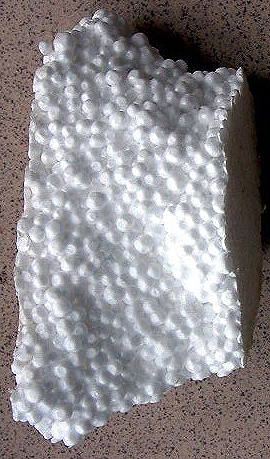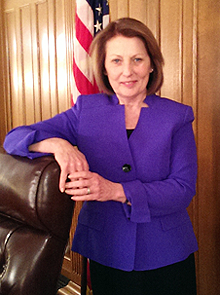While I was en route to hear the American Chemistry Council argue against a proposed ban on polystyrene in Putnam County, NY, National Public Radio broadcast a story about Jenna Jambeck of the University of Georgia whose study, published this week in Science, calculates the amount of plastic that enters the oceans annually:

Styrofoam (polystyrene) crumbles easily, as anyone who has played with some knows. Eventually it will crumble into nanoparticles of one ten millionth of an inch that are dangerous to fish life.
“In 2010 there were 8 million metric tons of plastic entering the ocean globally,” she says. That’s plastic bottles, candy wrappers, laundry baskets, synthetic rope, and syringes. According to Jambeck’s calculations, that’s like putting five bags of plastic trash on every foot of coastline in the world.
[…]
“If you have waste that’s free in the environment, on the land mass that’s in close proximity to the ocean,” she explains, “it’s going to be blown or be washed into the ocean. It also could be washed into rivers and then flow from there.”
Also part of that waste load are polystyrene products, such as clamshells, coffee cups, and “peanuts” used for packing material — items we most often refer to as Styrofoam®, though that is a trademarked term of the Dow Chemical Company. This “plastic tsunami,” as NPR called it, is an issue of worldwide concern, tackled mostly by local governments.
Michael Levy, director of the Plastics Foodservice Packaging Group of the American Chemistry Council, travels far and wide to defend the polystyrene industry. No community is too small for him to make his case. Any town could tip the balance toward a regional or statewide avalanche of prohibitions and regulations.
Legislator Barbara Scuccimarra, is passionately leading the ban effort in Putnam, the third smallest county in physical size in New York State outside New York City. In fact, 81% of the nation’s counties are larger. So small is Putnam, or so large is ACC, their budgets are comparable, though ACC reaps its revenues from a relative handful of chemical companies compared to the number of Putnam County taxpayers.

Putnam County Legislator Barbara Scuccimarra. Via PutnamCountyNY.com
Some comparisons:
The annual budget of Putnam County is $145,460,348.00, with a population of 99,645. County Executive MaryEllen Odell is paid $148,635. County Legislator Scuccimara is paid $35,136. (See: Putnam County 2015 Budget)
The annual budget of the American Chemistry Council is $121,261,865 with a membership of 150. President and CEO Calvin Dooley is paid $2,627,921. Michael Levy is paid $308,126. (See: ACC 2013 IRS Filing)
For now, if implemented, the proposed county ban will only pertain to county facilities — a further measure of how determined Levy is to use ACC’s considerable resources to head off opposition, no matter how small. Importantly, Scuccimara’s district covers the western side of the county embracing the tidal Hudson, a major estuary that interacts constantly with the Atlantic. During the last two decades, the river has seen a significant increase in plastic waste on its beaches, embayments, inlets and marinas.
Levy arrived in Putnam fresh from a major defeat at the hands of Mayor Bill de Blasio, who announced, over Levy’s objections and $1 million dollar lobbying effort:
[A]s of July 1, 2015, food service establishments, stores and manufacturers may not possess, sell, or offer for use single service Expanded Polystyrene (EPS) foam articles or polystyrene loose fill packaging, such as “packing peanuts” in New York City.

Happy woman holds polystyrene cup. Via American Chemistry Council
Last Thursday, Levy argued his case to Putnam’s Rules, Enactments & Intergovernmental Relations Committee. He said that polystyrene is non-toxic, more climate-friendly than paper, and takes up less space in landfills than most waste. It is not difficult to find evidence that contradicts each of his claims, such as a Harvard University fact sheet that also concludes:
Over 100 US and Canadian, as well as some European and Asian cities, have banned polystyrene food packaging as a result of the negative impacts to humans and the environment.
But most of Levy’s presentation was focused on the dual issue of solid waste and recycling, even offering Putnam assistance with the establishment of a polystyrene recycling facility to keep the material out of the solid waste flow. Oddly, he also testified that polystyrene is an insignificant constituent of the solid waste flow. There is no national recycling campaign by ACC; it is a recommendation it introduces when communities try to ban polystyrene.
New York City’s Department of Sanitation concluded it could not successfully recycle polystyrene. And the one supposedly successful recycling effort cited by Levy in the City of Los Angeles seems to have failed. The sheer number of containers contaminated by grease and food proved too much for LA’s recycling program, according to The New York Times:
[O]fficials there said they tried doing so, but stopped because “the end product was coming out contaminated,” said Michael Lee, that city’s project manager for curbside recycling. Los Angeles does recycle clean foam like packing materials, but “anything contaminated with food waste, oil grease, we don’t accept it,” Mr. Lee said.
Noticeably absent from his presentation was a discussion of plastic contamination of the aquatic and marine environment, such as the Pacific Gyre, where it is estimated that a gathering of plastic occupies an area of ocean the size of Texas. But one need look no farther than the Hudson River, right outside Putnam County’s door — that is, if you can even see the worst of the plastic pollution.
Polystyrene crumbles easily, as anyone who has nervously played with a Styrofoam cup knows. In the environment it continues to crumble to the microscopic stage. A January 6 study published in Environmental Science and Technology concludes that nanoparticles of polystyrene, particles in the range of one ten millionth of an inch, pose a significant risk to fish:
We found severe effects on feeding and shoaling behavior as well as metabolism of the fish; hence, we conclude that polystyrene nanoparticles have severe effects on both behavior and metabolism in fish and that commonly used nanosized particles may have considerable effects on natural systems and ecosystem services derived from them.
If past contamination issues are any indication, similar findings regarding other forms of wildlife, and humans, will not be far behind.









